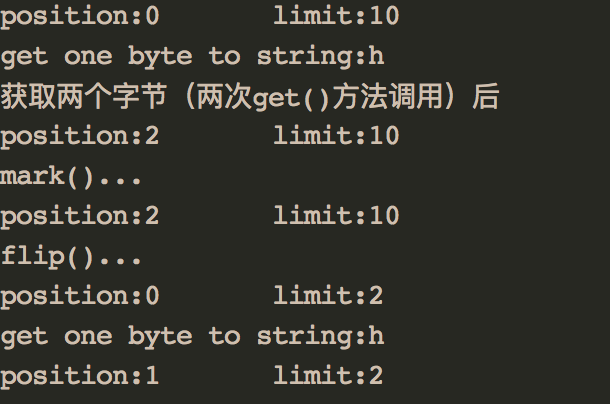参考博客:http://blog.csdn.net/sunzhenhua0608/article/details/31778519
先来一个demo:
import java.nio.ByteBuffer; public class ByteBufferDemo { public static void main(String[] args){ String str = "helloWorld"; ByteBuffer buff = ByteBuffer.wrap(str.getBytes()); System.out.println("position:"+buff.position()+" limit:"+buff.limit()); //读取两个字节 byte[] abytes = new byte[1]; buff.get(abytes); System.out.println("get one byte to string:" + new String(abytes)); //Reads the byte at this buffer's current position, and then increments the position. buff.get(); System.out.println("获取两个字节(两次get()方法调用)后"); System.out.println("position:"+buff.position()+" limit:"+buff.limit()); //Sets this buffer's mark at its position. like ByteBuffer.this.mark=position buff.mark(); System.out.println("mark()..."); System.out.println("position:"+buff.position()+" limit:"+buff.limit()); //当读取到码流后,进行解码。首先对ByteBuffer进行flip操作, //它的作用是将缓冲区当前的limit设置为position,position设置为0 //flip方法将Buffer从写模式切换到读模式。调用flip()方法会将position设回0,并将limit设置成之前position的值。
// 这里的flip()方法,在详细的描述一下,其事这里是理解position和limit这两个属性的关键。
//用于后续对缓冲区的读取操作。然后根据缓冲区可读的字节个数创建字节数组,
//调用ByteBuffer的get操作将缓冲区可读的字节(获取position到limit的字节)
//数组复制到新创建的字节数组中,最后调用字符串的构造函数创建请求消息体并打印。 buff.flip(); System.out.println("flip()..."); System.out.println("position:"+buff.position()+" limit:"+buff.limit()); byte[] tbyte = new byte[1]; buff.get(tbyte); System.out.println("get one byte to string:" + new String(tbyte)); System.out.println("position:"+buff.position()+" limit:"+buff.limit()); //BufferUnderflowException 测试 // byte[] trbyte = new byte[2]; // buff.get(trbyte); } }
输出:
